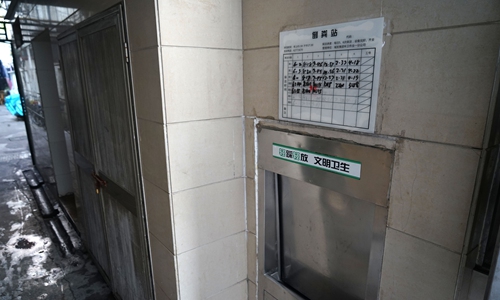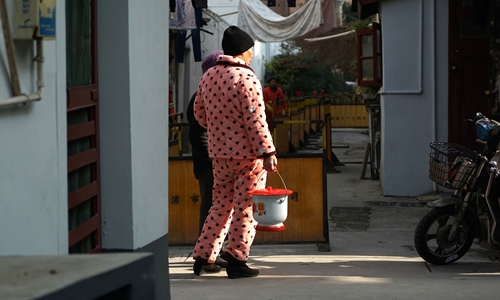HOME >> CHINA,METRO SHANGHAI
Toilet revolution: tale of Shanghai’s ‘embroidery work’
Source:Global Times Published: 2020/1/15 20:38:40
In Jing'an district, located in the heart of Shanghai, residents holding plastic or wooden buckets used to be a common morning sight. Their visible embarrassment as they hush up to pour the accumulated urine down the drain from these buckets made the sight utter astonishing.
These buckets dubbed as "portable toilets" or "portable night pots" were used for urinating over the night in the absence of flushable toilets. However, much changed post-2019. The quest to dump the concept of unhygienic, outdated and awkward, "portable toilets" was once of utmost urgency for the people living there. Thanks to the toilet revolution in Shanghai, the quest has become a reality.
The aim of Shanghai's toilet revolution is to replace these portable toilets with flush toilets. Not only rural areas but several parts of the urban-Shanghai came under the ambit of this scheme.
Lu Xiaodong, Secretary of the Jing'an District Party Committee, said that at the onset of 2019, a total of 2,029 portable toilets needed to be replaced with modern sanitation facilities. Keeping in mind the varied circumstances of each family, Lu launched a one toilet one policy. As of the end of 2019, only 39 portable toilets are yet to be replaced due to some difficulties, reported Shanghai Fabu, the official social media account by Shanghai municipal government.
There are hundreds of stories behind every toilet reconstruction. Recalling one of his family visits, Lu mentions about a woman telling him her home was too small and crowded to install a flush toilet. She told Lu many of her items have commemorative value and cannot be thrown away. Following which, Lu told the street comrades to arrange a storage expert who could guide the woman to rearrange the room. Finally, she vacated toilet space. Many residents, according to Lu's experience, did not understand the project initially and called it too troublesome. "We had to guarantee to shorten the construction period and improve construction efficiency. After the installation was completed, the residents' attitude made a 180-degree turn," said Lu.
Zhang Xiudi, 89, a resident of Zhijiang street said, "For me, this improvement is quite good."
Mrs Chen, a resident of Lane 731, on Baochang Road, shed tears of joy after seeing the installation process of the flush toilet in her house. "I didn't expect it; I really didn't expect them to help me install it so quickly," she said.
An official in charge of the Jing'an District Housing Management Bureau was cited by the Shanghai Observer, a local media outlet, as highlighting the following challenges to this project.
First, the installation work is difficult because housing conditions are complex. Since the houses without sanitary facilities are old structures, residents have a high living density, thus making it difficult to make room for flush toilets. Besides, other problems such as living area, structural safety, floor layout, and equipment placement lead to technical constraints. It is difficult to solve all of these.

Second, internal family conflicts and neighborhood disputes affect the pace of installation work. Due to conflicts within families or among tenants, some residents are reluctant to renovate or often refuse consent to repair works. At the same time, toilet reconstruction involves pipeline-laying, and as some residents cannot reach an agreement on using toilets by constantly climbing up and down the stairs, thus affecting the overall flow of work.
The process was not a smooth sail. The future situation may turn more complicated, and the process will be more difficult. "Residents have many difficulties, but no matter how challenging it turns out to be, we need to help them handle it together," Lu said.
Highlighting the outcomes, Lu said the process of eliminating portable toilets implies doing a good deed for the mass. Whether it is in-depth research, bitter persuasion, or a specific support plan, only by devoting ourselves to doing it, can government officials win the hearts of people. "I think the more international and prosperous Jing'an is, the more attention we should pay to people's livelihood. Letting the people of Jing'an live and work happily with satisfaction has always been my goal," he said.
As an international metropolis, Shanghai is now doing "embroidery work" on the details of the city. According to Shanghai City Appearance and Environmental Quality Monitoring Center, the aim of "toilet revolution" is not only to create a simple toilet for convenience, but also to create a multifunctional toilet catering to more needs. Not only to meet the general needs of people, but also to meet the individual needs. Ecological toilets, humane toilets, and technology-laded toilets will shine on the horizon of this toilet revolution.
(The article was translated by Deng Jiahuan based on reports on Shanghai Fabu, Shanghai Observer)
These buckets dubbed as "portable toilets" or "portable night pots" were used for urinating over the night in the absence of flushable toilets. However, much changed post-2019. The quest to dump the concept of unhygienic, outdated and awkward, "portable toilets" was once of utmost urgency for the people living there. Thanks to the toilet revolution in Shanghai, the quest has become a reality.
The aim of Shanghai's toilet revolution is to replace these portable toilets with flush toilets. Not only rural areas but several parts of the urban-Shanghai came under the ambit of this scheme.

A resident living in West Beijing Road in downtown Shanghai is on the way to pour the accumulated urine in the morning, holding a portable toilet. Photo: Yang Hui
Lu Xiaodong, Secretary of the Jing'an District Party Committee, said that at the onset of 2019, a total of 2,029 portable toilets needed to be replaced with modern sanitation facilities. Keeping in mind the varied circumstances of each family, Lu launched a one toilet one policy. As of the end of 2019, only 39 portable toilets are yet to be replaced due to some difficulties, reported Shanghai Fabu, the official social media account by Shanghai municipal government.
There are hundreds of stories behind every toilet reconstruction. Recalling one of his family visits, Lu mentions about a woman telling him her home was too small and crowded to install a flush toilet. She told Lu many of her items have commemorative value and cannot be thrown away. Following which, Lu told the street comrades to arrange a storage expert who could guide the woman to rearrange the room. Finally, she vacated toilet space. Many residents, according to Lu's experience, did not understand the project initially and called it too troublesome. "We had to guarantee to shorten the construction period and improve construction efficiency. After the installation was completed, the residents' attitude made a 180-degree turn," said Lu.
Zhang Xiudi, 89, a resident of Zhijiang street said, "For me, this improvement is quite good."
Mrs Chen, a resident of Lane 731, on Baochang Road, shed tears of joy after seeing the installation process of the flush toilet in her house. "I didn't expect it; I really didn't expect them to help me install it so quickly," she said.
An official in charge of the Jing'an District Housing Management Bureau was cited by the Shanghai Observer, a local media outlet, as highlighting the following challenges to this project.
First, the installation work is difficult because housing conditions are complex. Since the houses without sanitary facilities are old structures, residents have a high living density, thus making it difficult to make room for flush toilets. Besides, other problems such as living area, structural safety, floor layout, and equipment placement lead to technical constraints. It is difficult to solve all of these.

The drain used to pour the accumulated urine down for portable toilets Photo: Yang Hui
Second, internal family conflicts and neighborhood disputes affect the pace of installation work. Due to conflicts within families or among tenants, some residents are reluctant to renovate or often refuse consent to repair works. At the same time, toilet reconstruction involves pipeline-laying, and as some residents cannot reach an agreement on using toilets by constantly climbing up and down the stairs, thus affecting the overall flow of work.
The process was not a smooth sail. The future situation may turn more complicated, and the process will be more difficult. "Residents have many difficulties, but no matter how challenging it turns out to be, we need to help them handle it together," Lu said.
Highlighting the outcomes, Lu said the process of eliminating portable toilets implies doing a good deed for the mass. Whether it is in-depth research, bitter persuasion, or a specific support plan, only by devoting ourselves to doing it, can government officials win the hearts of people. "I think the more international and prosperous Jing'an is, the more attention we should pay to people's livelihood. Letting the people of Jing'an live and work happily with satisfaction has always been my goal," he said.
As an international metropolis, Shanghai is now doing "embroidery work" on the details of the city. According to Shanghai City Appearance and Environmental Quality Monitoring Center, the aim of "toilet revolution" is not only to create a simple toilet for convenience, but also to create a multifunctional toilet catering to more needs. Not only to meet the general needs of people, but also to meet the individual needs. Ecological toilets, humane toilets, and technology-laded toilets will shine on the horizon of this toilet revolution.
(The article was translated by Deng Jiahuan based on reports on Shanghai Fabu, Shanghai Observer)
Posted in: SOCIETY,METRO SHANGHAI